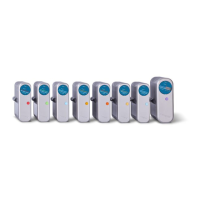ENGINEERING MANUAL OF AUTOMATIC CONTROL
ELECTRIC CONTROL FUNDAMENTALS
100
SERIES 40 CONTROL CIRCUITS
APPLICATION
A Series 40 circuit is a line-voltage control circuit which is
switched directly by the single-pole, single-throw switching action
of a Series 40 controller. A Series 40 control circuit is two position
and requires two wires. It can be used to control fans, electric
motors, lights, electric heaters, and other standard line-voltage
equipment in addition to relays and spring-return actuators.
The equipment controlled is energized when the controller
switch is closed and deenergized when the switch is open.
Normally, a Series 40 controller closes and opens the circuit
load directly. However, when a load exceeds the contact rating
of the controller, an intermediate (pilot) relay with higher contact
ratings must be used between the controller and the load circuit.
Also a relay can be used if a load circuit requires double- or
multi-pole switching action. The Series 40 controller energizes
the coil of the relay to actuate the contacts.
Series 40 controllers which operate at line voltage must be
wired according to codes and ordinances for line-voltage
circuits. Series 40 controllers when used to switch low voltage
can be wired according to low-voltage circuit requirements.
EQUIPMENT
CONTROLLERS
1. Temperature controllers.
2. Pressure controllers.
3. Humidity controllers.
4. Other two-position devices that have a normally open or
normally closed contact action such as a line-voltage relay.
In these controllers, either snap-acting or mercury switch
contacts close and open the circuit. In most cases, Series 40
controllers are snap-acting. Series 40 controllers can be used
in low-voltage circuits, but low-voltage controllers cannot be
used in Series 40 line-voltage circuits.
RELAYS
A Series 40 relay consists of a line-voltage coil which operates
an armature to control one or more normally open or normally
closed, or single-pole, double-throw contacts.
ACTUATORS
Series 40 actuators usually operate valves or dampers. The
actuator is electrically driven through its stroke (usually either
90 or 160 degrees) when the controller contact is closed. A
limit switch in the motor opens at the end of the power stroke,
the actuator stops, and the drive shaft is held in position by a
solenoid brake (Fig. 4), or one of the motor windings (Fig. 5),
as long as the circuit is closed. When the controller circuit opens
or a power failure occurs, the solenoid brake (or motor winding)
releases and an integral spring returns the actuator to the
deenergized position. Series 40 actuators should be used in
applications that do not require frequent cycling due to the high
speed spring return.
Fig. 4. Series 40 Actuator Circuit
with Low-Voltage Motor.
CONTROLLER
T1 T2
L1
L2
LIMIT
SWITCH
SOLENOID
BRAKE
ACTUATOR
LINE VOLTAGE
TRANSFORMER
C2505
MOTOR
DRIVE
SHAFT
CAM

